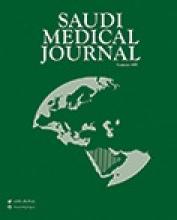To the Editor
I have 3 comments on the distinguished study by Al-Agha and Mahjoub on the impact of body mass index (BMI) on high blood pressure (BP) among obese children in the western region region of kingdom of Saudi Arabia (KSA).1
First, Al-Agha and Mahjoub found that BMI increased systolic BP (SBP) by 1.722 mm Hg (p=0.001), and diastolic BP (DBP) by 0.901 mm Hg (p=0.006) in boys, and 0.969 mm Hg (p=0.036), and DBP by 0.704 mm Hg (p=0.045) in girls.1 They concluded that elevated BMI is associated with significantly increased DBP and SBP in obese children, especially in children older than 11 years.1 They pointed one study limitation as they completed only 2 measurements of BP instead of the gold standard approach of 3 separate measurements.1 I presume that the following 2 limitations might be additionally contributory. 1) Al-Agha and Mahjoub1 conducted their cross-sectional study between August 2016 and March 2017. They referred to the Centers for Disease Control (CDC) growth charts to estimate BMI percentiles for each subject.1 It is explicit that in the clinical field, there are many growth charts used to measure various anthropometric parameters in children, notably World Health Organization (WHO) charts, CDC charts, and country-specific charts. Comparing the use of other charts to the use of the country-specific growth charts suggested that the latter might describe the growth of children more precisely.2 In certain populations, the clinical implementation of national charts showed unique patterns of BMI curves compared to WHO and CDC references. These national charts were considered useful as a reference for comparing different regions and for monitoring changes over time.3 To my knowledge, L, M, and S parameters and z scores were calculated for weight, height, and BMI for Saudi school-age children and adolescents and they have been launched in 2016 for more accurate assessment of growth and nutrition in various clinical conditions and research.4 The L, M, and S parameters and z scores for weight for age, height for age, and BMI for age for boys and girls have been presented in detailed tables across the age of commonly used z scores (+3, +2, +1, 0, -1, -2, -3). Moreover, graphs corresponding to the same parameters (weight, height, and BMI) showing the main z scores across all ages from 5 to 18 years have been illustrated.4 I wonder why Al-Agha and Mahjoub1 did not refer in their study to the national Saudi growth charts to precisely estimate BMI percentiles instead of CDC charts. I presume that if they employed national BMI standards, the study results might be altered. 2) In the methodology, Al-Agha and Mahjoub1 used 2004 National High Blood Pressure Education Program Working Group (NHBPEPWG) guidelines for the classification of BP measurements in the studied population. It is obvious that BP levels might vary in populations because of various factors, including genetic, ethnic, nutritional, and socioeconomic backgrounds. Establishing the local reference values based on the aforementioned factors is advocated to understand better the BP profile and stages of hypertension in a given community.5 To my knowledge, reference values for the distribution pattern of SBP and DBP for Saudi children and adolescents were constructed more than a decade ago.6 I wonder again why Al-Agha and Mahjoub1 did not refer in their study to the national Saudi BP reference values to accurately estimate BP pattern instead of 2004 NHBPEPWG guidelines. I presume that if they adopted national BP data, different results might be obtained.
Second, Al-Agha and Mahjoub mentioned that high BMI significantly correlated with increased SBP and DBP in obese children. However, waist hip ratio did not show significant correlation.1 It should be noted that children and adolescents with low BMI but large waist circumference (WC) might have an increased risk of increased BP and their health risks would be underestimated if screening by BMI alone was carried out. Therefore, estimation of WC might be an assistive tool when using BMI to identify hypertension risks.7
Third, pediatric hypertension and obesity have both been on the rise worldwide. Each is associated with increased risk of cardiovascular diseases and both track into adulthood, increasing significantly the morbidity and mortality.8 All obese children are suggested to be screened for hypertension.8 To my knowledge, obesity and hypertension are worrisome health hazards in KSA. Based on the significant contribution of elevated BMI to the increased DBP and SBP in obese Saudi children 1 and the substantial prevalence of obesity (19.2%) and hypertension (17.2%) among Saudi children aged 11-18 years,9 I presume that screening obese children for hypertension in KSA needs to be seriously considered.
Reply from the Author
We are thankful to Professor Al-Mendalawi for his comments on our article “Impact of body mass index on high blood pressure among obese children in the western region of Saudi Arabia”.1 We do agree with his valuable comment.
- Copyright: © Saudi Medical Journal
This is an open-access article distributed under the terms of the Creative Commons Attribution-Noncommercial-Share Alike 3.0 Unported, which permits unrestricted use, distribution, and reproduction in any medium, provided the original work is properly cited.






